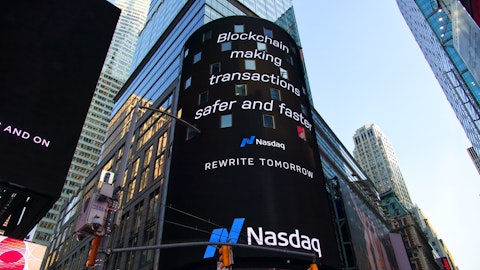Alexander Goldfarb: Great. Thank you. Morning down there. So, question on development. In the release, you guys talked about an extension until February ’24 for your 25% stake in the 3 Hudson, in the land loan that’s under 3 Hudson. And at the same time, articulated your optionality on the MTA site. Just looking at the two projects, the MTA site would seem to be like the winner just given the focus on Grand Central, Park Avenue, whereas 3 Hudson just seems like a more challenged deal given the economics of trying to lease up that building at the necessary rent given the size of that building. So, as you guys think about the upcoming land loan on 3 Hudson, is that something that you would consider just sort of exiting instead of pursuing, and mentioning the MTA optionality, should we take that as considering that maybe you guys would not proceed forward with the MTA site?
Douglas Linde: Yeah. So Alex, this is Doug. I’m going to let Hilary give you the most detail on this. I would just make the following comment, which is, we don’t think one is a winner versus the other. I think it’s clear that the timing opportunities associated with one are probably shorter than the other in terms of when we might actually get something going. But I’ll let Hilary describe the demand for space in new buildings and also the challenges associated with getting those deals going. Hilary?
Hilary Spann: Thanks, Doug. Hi, Alex. So, as Doug noted, the two buildings are very, very different opportunities. 3 Hudson Boulevard is a 1.8 million square foot building, whereas 343 Madison is currently still in the design process, but let’s just call it, 850,000 square foot to 900,000 square foot building. So, some of the demand that is currently in the market actually could not be satisfied by 343 Madison. So there are a few tenants in the market that are 1 million square feet, that are actively looking for space and they would need a larger building than what can be constructed at 343 Madison. To Doug’s point, in order to build such a building, those clients would have to be willing to pay a rent that generated an acceptable return on cost to us at 343 Madison.
And those decisions in this capital market environment takes time for clients or prospective clients like those to make. The prospective client base at 343 Madison, by definition, is somewhat smaller. There’s plenty of demand among clientele in that square footage range as well. And again, the question really comes down to who’s willing to commit to the project at the rents needed to launch the development. But I view them as distinctly different opportunities. And opportunities that serve different segments of the market. So, hopefully, that answers your question. But I agree with Doug. I wouldn’t characterize one as better than the other. They’re just very, very different opportunities.
Operator: Thank you. And I show our next question, comes from the line of Michael Griffin from Citi. Please go ahead.
Michael Griffin: Great. Thanks. I think in your prepared remarks, you mentioned some assets you’re considering for sale. I’m just curious if you can quantify, what kind of IRRs buyers are looking at and kind of where pricing would need to be in order for you to effectuate on any of these potential sales?
Owen Thomas: Well, I think it varies, Michael, widely, depending on the quality and location of the asset, the leasing status of the asset, the walls of the asset. I think borrowing cost today with the 10-year, I guess it’s dropped a little bit today, but pushing 7%, I think for the highest quality assets, you’re definitely above that. And for an asset that has a lot of leasing and other risks associated with it. I think you’re looking at double-digit return.
Operator: Thank you. And I show our next question, comes from the line of Michael Goldsmith from UBS. Please go ahead.
Michael Goldsmith: Good morning. Thanks a lot for taking my question. Owen, you mentioned in the prepared remarks about how BXP’s tenants are more cautious in the space commitments on many of the traditional macro indicators may not accurately reflect what’s going on in your business. So, recognizing that different cycles have different drivers. What metrics do you think might more accurately reflect the business now, and are the ones that you’re monitoring so that we can follow along at home? Thanks.
Owen Thomas: Well, so I think this is part of something that’s been confusing in the marketplace because generally, when you have a recession, company’s earnings are down. And they lease less space, and that’s what’s help cycles have traditionally operated for office companies, because leasing slows down when you have a recession. Here, it’s confusing because it’s very different. All the economic indicators look favorable, GDP growth, employment statistics. But if you dig into those statistics, it’s a lot of its consumption related. And a lot of the job creation isn’t in office using jobs. And then if you look at earnings, which is what our clients are looking at, is their own earnings trajectory, it’s negative. It’s been negative for the last year, assuming the third quarter is negative.
So, that is the driver of client behavior. If you’re the CEO of a company, and your lease is coming up or you’re thinking about your space requirement, your decisions about that are going to be very contingent upon what you think the future prospects of your business are. And many businesses are negatively impacted by rising rates and some of the uncertainty in the economic environment. So, that’s the backdrop. And so I think coming back to your question, I think certainly lower rates will help. And I think as earnings generally rise, I would expect that our leasing activity will rise with it.
Douglas Linde: And Michael, this is Doug. I would just say that the best measure of corporate activity as it relates to the business that we are in, is job growth. And job growth typically is a little bit murkier. You can look at the employment numbers, but you really have to get into the specific industry categories, right? So government and hospitality are not going to be favorable to office, but financial services or technology or life sciences are going to be. And as you start to see the job listings start to perk up a bit, as you start to see hiring announcements by many of the larger technology companies and some of the financial institutions, which do in fact, broadly talk about those things, you will clearly see a more, I would say, conducive environment for office leasing on a going forward basis.
Operator: Thank you. And I show our next question comes from the line of Jason Wayne from Barclays. Please go ahead.
Jason Wayne: Good morning. You said in your prepared remarks, you don’t expect WeWork to exit all of their assets. So, just wondering where you expect them to stay. And then you previously said that WeWork security deposits average eight months of rent. Is that a good number to think about when looking at termination income moving forward?




